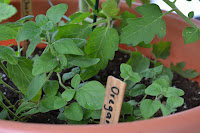Hi again, good to have you back! Today we have another edition of Tricks and Treats© for basil: Yucky, Yummy Edition! Specifically, we’ll talk about basil common diseases and some ideas on how to use basil.
Tricks for the Yucky!
Always starting at the root… root rot is fairly common with basil. As the fungi needs moist cool soil to grow in, root rot might present by over-watering the plant. As a first sign, be alert for lower foliage that turns yellow or drops off the plant. The roots of the plant will appear brown and mushy, unlike healthy roots that appear firm and tan in color. To get rid of it, change the soil of the plant and decontaminate the container with a mix of 9 parts water, 1 part bleach.
Basil can suffer from several foliar diseases that can ruin the crop and reduce yield.
 |
| Gray Mold on our culantro leaves |
A common disease of basil is gray mold; it looks exactly as it sounds. It can also cause infections post-harvest and is capable of killing the entire plant. Black spots can also be seen on basil foliage. Both can be controlled by spraying the leaves with a mix of half a gallon of water and one teaspoon of baking soda (not powder!).
Treats are the Yummy!
Basil Vinegar
Take all your excess basil snippings (which you’ll have lots when the plant starts flowering), stuff them loosely into a glass jar with a fitting lid, and pour enough vinegar to cover all foliage. Red wine vinegar is a great complement for basil. Wait about a week, during which time the vinegar will extract the flavor, aroma and color from the basil. Strain off, discard the snippings and voilà you have made basil vinegar!
When using basil vinegar for cooking, use your imagination. It sure can make a delicious salad dressing but you could also add it to pot roasts, stews, sauces or even over steamed vegetables. If you enjoy basil fragrance so much, another delightful use for basil vinegar is in the bath. Oh yes, soak yourself in aromatic hot water heaven. Add about a cup of basil vinegar to the bathwater, slip in and enjoy. Basil stimulates blood circulation so it is both invigorating and relaxing. Don’t be afraid to sink in and start making bubbles, basil vinegar can also be used as hair rinse. The vinegary smell dissipates quickly and you’re left a gentle herbal fragrance on your hair.
Pesto
Nope. The Pesto Night Story is not today. Pesto is traditionally made with pine nuts, garlic, olive oil, basil, and Parmesan cheese. It's most popular use is tossed with pasta.
Ingredients:
- 4 cups basil leaves
- 1/2 cup grated fresh Parmesan cheese
- 2 tablespoons coarse-chopped pine nuts
- 2 garlic cloves, peeled
- 3 tablespoons extra-virgin olive oil
- 1/4 teaspoon salt
Preparation:
In a food processor or strong blender, with the motor running, drop the pine nuts and garlic through the feed chute. Process until finely minced. Add the olive oil and pulse three times. Add basil, Parmesan cheese, and salt to the processor bowl. Process until finely minced. Refrigerate leftovers and use within 1 week.
Have you bought your basil seeds? What are you waiting for!



























